Serviços Personalizados
Artigo
Indicadores
Links relacionados
-
 Citado por Google
Citado por Google -
 Similares em Google
Similares em Google
Compartilhar
South African Journal of Agricultural Extension
versão On-line ISSN 2413-3221
versão impressa ISSN 0301-603X
S Afr. Jnl. Agric. Ext. vol.42 no.2 Pretoria Dez. 2014
Livestock extension programmes participation and impact on smallholder cattle productivity in KwaZulu-Natal: A propensity score matching approach
Ndoro J. T.I; Mudhara M.II; Chimonyo M.III
ICorresponding Author: Lecturer, Agricultural Extension Programme, University of Mpumalanga, Private Bag X11283 Riverside, 1200, Nelspruit, South Africa Email: jorinendoro@gmail.com
IICo-author: Lecturer, African Centre for Food Security, University of KwaZulu-Natal, Private Bag X01 Scottsville, 3209, Pietermaritzburg, South Africa
IIICo-author: Professor, Discipline of Poultry and Animal Sciences, University of KwaZulu-Natal, P/Bag X01 Scottsville, 3209, Pietermaritzburg, South Africa
ABSTRACT
In rural South Africa, the sustainability of cattle-based livelihoods is threatened by the competition for natural resources such as land and water. The central and provincial governments continue to invest funds in agricultural extension in order to uplift the productivity and safeguard the multifunctionality of cattle farming. However, the design of effective and efficient livestock extension models remains a challenge. The objective of this study was to investigate the drivers and first-order impacts of participation in livestock extension programmes in the KwaZulu-Natal province. To that end, the study adopted the propensity score matching (PSM) method. Based on data from a survey of 230 smallholder farmers in 13 communities of the Okhahlamba Local Municipality, the results of the Probit model showed that the likelihood of participation in extension programmes decreases with education, and increases with group membership, distance from the extension office, adoption of mixed breed, herd size and usage of forage and feed supplements, suggesting a largely supply-driven extension approach. Based on the nearest neighbour and kernel matching algorithms, the results further showed that benefits accrued from participating in livestock extension programmes in terms of cattle production and input use were scant. The study concludes with some policy implications.
Keywords: Agricultural Extension, Cattle production, Impact evaluation, Propensity Score Matching, South Africa.
1. INTRODUCTION
The integration of subsistence-orientated smallholder farming into the market economy has received considerable attention among rural development policy makers and researchers around the world (Barrett, 2008). A common argument is that in order to produce marketable surpluses and sustain food security, smallholder farmers need not only access to agricultural technologies, but also private assets (e.g. land, equipment, etc) and public goods (Barrett, 2008). Among public goods, there is convincing evidence that agricultural extension services have significant impact on farm productivity (Birkhaeuser, Evenson, & Feder, 1991). Indeed, empirical evidence in developing countries suggests that the impact of access to agricultural extension on poverty reduction is greater than the impact of access to infrastructure (Dercon, Gilligan, Hoddinott, & Woldehanna, 2009). Moreover, investment in agricultural extension ensures increased returns in both developing and developed countries (Birkhaeuser et al., 1991; Evenson, 2001).
In South Africa, there is an increasing demand for livestock products. A report on the beef value chain profile estimates that there was a 54 % increase in beef consumption in 2009/10 compared to 2000/1 (Republic of South Africa, 2011). This increase has been driven by demand factors such as high population growth, income growth, urbanization, globalization, and their associated changes in lifestyles and consumer preferences (Coetzee, Montshwe, & Jooste, 2006; Groenewald & Jooste, 2012; Thornton, 2010; Uchezuba, Moshabele, & Digopo, 2009). Nevertheless, the country does not produce enough beef to meet its domestic demand (Republic of South Africa, 2011).
Beef cattle production, however, remains a spatially important and multifunctional livelihood strategy in rural South Africa, particularly in marginal and remote areas with degraded lands and meagre economic opportunities. Estimates suggest that around 69 % of the country's agricultural land is under extensive grazing, and 5.6 million cattle (40 % of the total cattle population) are owned by 240 000 small-scale farmers and 3 million subsistence farmers (Republic of South Africa, 2011). For the livelihoods of these smallholder farmers, cattle farming has multiple functions, both commercial and non-commercial (Swanepoel, Stroebel, & Moyo, 2010). Non-commercial motives include economic functions (e.g. wealth storage), agro-economic functions (e.g. provision of draught power), agro-ecological functions (e.g. provision of manure), nutritional (e.g. provision of milk for infants) as well as socio-cultural functions (e.g. dowry) (Groenewald & Jooste, 2012; Musemwa, Mushunje, Chimonyo, & Mapiye, 2010; Ndoro & Hitayezu, 2014; Stroebel, Swanepoel, & Pell, 2011).
The sustainability of cattle-based livelihoods, however, is threatened by the competition for natural resources such as land and water. Despite the decrease in total grazing area due to the expansion of human settlements, mining, cropping, forestry and conservation, cattle production has increased by a million from 1994 to 2004 (Republic of South Africa, 2011). The increase owes to the recent development in breeding, nutrition and animal health that has contributed to increased potential production, efficiency and genetic gains (Thornton, 2010). This development has induced major changes in commercial beef production systems in the country, and has highlighted the importance of transfer of advanced knowledge to smallholder farmers.
Governments' involvement in agricultural knowledge diffusion has been justified by the public-good nature of agricultural information, coupled with the increasing gap between smallholder and commercial farm productivities (Birkhaeuser et al., 1991). In South Africa, the central government, as well as provincial governments, continue to invest funds in agricultural extension. KwaZulu-Natal (KZN), a province contributing about 11 % to the South Africa's total beef production (Republic of South Africa, 2011), has the country's highest agricultural extension expenditure at provincial level (Worth, 2012). The KwaZulu-Natal Provincial Treasury (2011) reported that around R686 million was spent on agricultural extension and advisory services between 2010 and 2011, and estimated a 50 % increase by end of 2014. In total, the agriculture development services programme's budget line supported 4 185 agricultural demonstrations, 371 farmers' days, and 861 functional commodity groups during the 2010/11 fiscal year.
However, the design of appropriate agricultural extension models for South Africa remains a major challenge. For the purpose of effectiveness, there has been increasing efforts to shift from a largely supply-driven technology transfer model, towards a demand-driven, farmer-centred approach (Düvel, 2004; Republic of South Africa, 2005; Williams, Mayson, de Satgé, Epstein, & Semwayo, 2008; Worth, 2006). This situation underscores the importance of empirical research on smallholder farmers' demand for agricultural extension information and the effectiveness of such information in terms of uplifting their productivity. Nonetheless, empirical studies investigating the drivers of livestock extension programme participation and the impact of such programmes on farm productivity, technology adoption, and knowledge in South Africa remains scanty (Evenson, 2001; Taye, 2013).
Against this backdrop, the objective of this study is to investigate the drivers and first-order impacts of participation in government-run livestock extension programmes in north-western KZN. Based on data from a household survey of 230 farmers conducted in 13 communities of the Okhahlamba Local Municipality, this study uses the propensity score matching (PSM) approach to investigate the influence of cattle farmer's characteristics on the decision to participate in livestock extension programmes and to generate propensity scores that are matched for the investigation of the impacts on cattle productivity and input use. The purpose is to provide evidence-based information on challenges that need to be addressed during the design of the national policy on extension and advisory services.
The remainder of this article is organized in three sections. Section 2 provides contextual information about the study site, data collection methods used, and the theoretical and empirical frameworks. Section 3 reports the results and discusses the key findings. Section 4 draws some concluding remarks.
2. MATERIAL AND METHODS
2.1 Study area, sampling and data
This study was conducted in the KZN province of South Africa. The focus was on the Okhahlamba Local Municipality (OLM), a 344 000ha municipality in the uThukela District. As shown by the land use map in Figure 1, commercial and subsistence farming coexist in this region, although geographically separated by a legacy of the segregationist apartheid regime. Smallholder farmers (mainly engaging in maize, vegetable, and livestock production) occupy the marginal areas of the foothills of the Drakensberg mountain chain, characterized by low-fertility lands (Elleboudt, 2012). Although only 22 % of the economically active population engage in crop production (Okhahlamba Local Municipality, 2012), 55 % of households living on communal land reportedly engage in livestock farming, mainly consisting of cattle, goats and sheep production (Elleboudt, 2012).
Crop-livestock farming systems are a common feature of agriculture in the foothills of Drakensberg region. A common grazing system is scheduled such that cattle are sent uphill during the cropping season, while all the land becomes grazing land during the off-season in winter (Elleboudt, 2012). This situation creates overstocking tendencies with the associated environmental consequences, and the status quo is reinforced by the lack of property rights and enforcement mechanisms such as fencing. The area also experiences harsh climatic conditions, characterized by an interchange of prolonged droughts and low winter temperatures interspaced with snow spells. Palatability of the natural grasslands is seasonal, necessitating supplementary feeding of animals.
Livestock extension services play a major role in the transformation of the livestock sector in the area. Using the training and visits (T & V) extension model, the municipal extension office located in the Bergville town is responsible for the development of livestock farmers' organizations, pastures, veterinary services, dip-tanks, and marketing facilities. Under the auspices of the Municipality's livestock extension office, around 31 dip tanks are operational in the area (see locations in Figure 1) and managed by the Okhahlamba Livestock Cooperative (OLC). All cattle farmers are members of the Dip-tank Users Associations (DUAs). The livestock extension office is also responsible for scheduling cattle auctions at the Dukuza dip tank (see location in Figure 1).
The collection of data in OLM was performed in two phases. The information gathered during the participatory rural appraisal phase was used to devise a structured household survey questionnaire. During the second phase (from November 2012 to February, 2013), the questionnaire was pilot-tested and administered by trained field enumerators. Farm households were randomly selected based on a two-stage random sampling technique. In the first stage, 13 out of 31 DUAs were randomly selected using simple random selection technique. In the second stage, members in each pre-selected DUA were randomly sampled with probability proportional to size. As shown in Table 1, this sampling method resulted in a sample of 230 farm households keeping cattle.
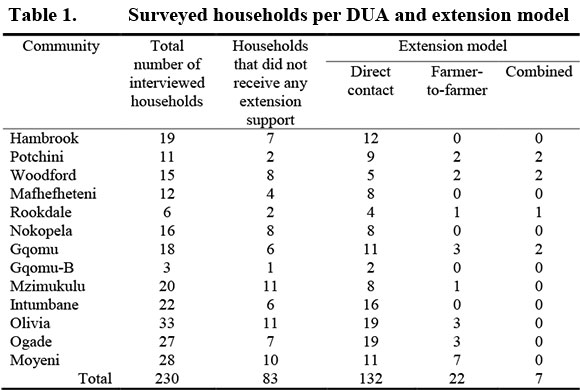
Table 1 show that only 63 % of interviewed households had received extension services. The direct contact with extension workers during T&V sessions dominates extension service delivery in the area. Interviewed households had participated in farmer-to-farmer extension services only to a level of 9.5 %. Very few farmers (3 %) had participated in both direct contacts and farmer-to-farmer extension sessions. As described in Table 2, the majority of interviewed cattle farmers kept mixed breeds. Pure Nguni breed was also prevalent among sampled households. Table 3 reports the herd composition among surveyed communities. As expected, cows dominated, whereas bulls made up the lowest proportion.
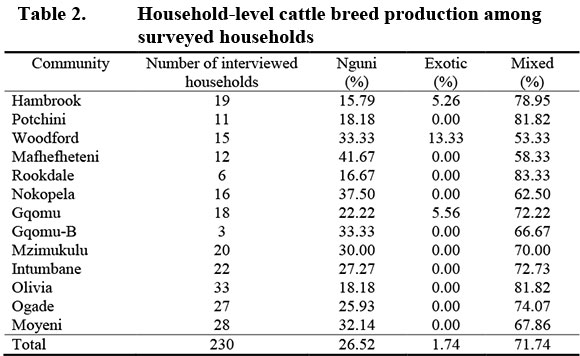
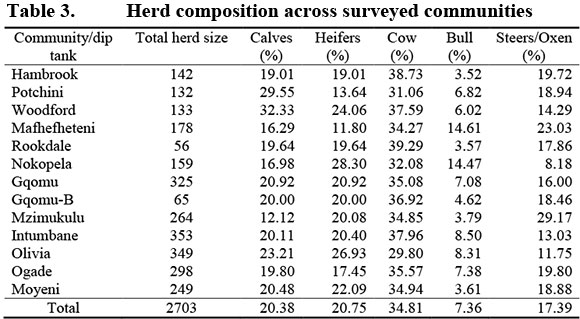
2.2 Theoretical perspective of extension programmes participation
The economic science posits that, with limited information availability, the lack of awareness of new technologies as well as inaccurate perceptions of their costs and benefits make smallholder farmers' resource allocation decisions and technology choices to deviate from the social optimum (Birkhaeuser et al., 1991). Like any other input in the classical production function, the demand for extension information is derived from the underlying demand for farm outputs, based on profit maximization behaviour. As such, the demand for extension information is inversely related to the cost of making extension contact, other input prices remaining constant (Bagi & Bagi, 1989).
There are other relevant factors that also affect the demand for extension services. The stage in life cycle of a household influences negatively the decision to participate in extension services, as younger farmers are less risk averse (Pålsson, 1996), more flexible, and, therefore, more willing to participate in innovative activities, compared to older farmers. Household structure can have positive effect on the participation in extension programmes. Household extension facilitates occupational diversification and, thus, serving to reduce income risk associated with new technologies (Rosenzweig & Wolpin, 1985). Gender of the head of household can be linked to factors that indirectly influence the demand for extension. Extension workers might prefer to visit farmers with more land or with better access to labour to implement new technologies, which could be negatively correlated to female-headedness (Doss & Morris, 2000). Moreover, the attitudes towards new technologies are more salient among men, i.e. they are more focused on the technology whereas subjective norms and perceived behavioural controls are more salient for females (Venkatesh, Morris, & Ackerman, 2000).
Education and farming experience enhance farmers' ability to understand the costs and benefits of technology, interpret, and modify extension information (Bagi & Bagi, 1989; Elias, Nohmi, Yasunobu, & Ishida, 2013; Elias et al., 2013). The numeracy, modernity, and agricultural knowledge pertaining to education might influence the likelihood of adoption of new agricultural technology (Jamison & Moock, 1984). Education has higher payoffs in modernizing and cosmopolitan environments than static and traditional ones (Lockheed, Jamison, & Lau, 1980).
Wealth can positively influence the demand for extension services. Wealthier farmers are more capable of bearing the risk of new technologies, and therefore more likely to participate in technology transfer programmes (Langyintuo & Mungoma, 2008). Group membership affects the demand for agricultural extension by way of economies of scale, and it also affects extension service supply (particularly in the standard T&V approach), as extension workers often target group members as their contact farmers (Anandajayasekeram, Ranjitha, Sindu, & Dirk, 2008; Davis, 2008). Lastly, the demand for extension information may increase with farm size, due to economies of size in obtaining and using information services, increasing demand for management services as farm size increases, and agricultural research may be primarily focused to specific problems faced by large-scale farmers (Bagi & Bagi, 1989).
2.3 Empirical approach
Following previous agricultural extension impact assessment studies such as Davis et al. (2012), Deschamps-Laporte (2013), Elias et al. (2013) and Wordofa & Sassi (2014), this study adopts the semi-parametric PSM approach (Rosenbaum & Rubin 1983) to investigate decisions to participate in agricultural extension programmes and assess the effect on cattle productivity and inputs use. This technique aims at minimizing the potential bias resulting from the selection problem using non-experimental data. This problem arises when the pre-treatment characteristics of the farmers participating in the agricultural extension programmes do not match those of non-participating (control group) so as to ascertain that any difference in these groups is attributable to extension programmes.
Therefore, for a farmer i, (where i=1...I, and I denotes the population of farmers), the major task of impact evaluation studies is to separate the impact of extension programmes participation (Di=1) on a certain outcome Yi(Di) from what would have happened anyway to the farmer without participating in extension programmes (Di=0), the so called counterfactual scenario. As shown in equation (1), this is done by differentiating the observed outcome for a participating farmer i and the counterfactual potential outcome without/before participating.

The impact  cannot be observed, since in an ex post setting, a farmer is either a participant or non-participant, but not both. This situation shifts researchers' attention to the average population effect. This consists of estimating the average treatment effect on the treated (ATT) defined as follows:
cannot be observed, since in an ex post setting, a farmer is either a participant or non-participant, but not both. This situation shifts researchers' attention to the average population effect. This consists of estimating the average treatment effect on the treated (ATT) defined as follows:

Since  is unobservable, the technique consists of subtracting the unobserved effect of the participating group
is unobservable, the technique consists of subtracting the unobserved effect of the participating group  had they not participated in extension programmes.
had they not participated in extension programmes.

The right-hand side of the equation represent the impact under investigation, while the two last terms on the right-hand side stand for the selection bias. Hence, the identification of the true impact  can only be done if:
can only be done if:

To solve the selection bias, the identification problem assumes that farmers with identical characteristics (X) that are not affected by extension will observe similar outcomes without participating in extension programmes. Such an assumption is commonly referred to as conditional independence assumption (CIA) (Rosenbaum & Rubin, 1983). Within the two groups, few participating farmers could be comparable to non-participating farmers, but selecting this subset is technically difficult because it is based on high-dimensional set of pre-treatment characteristics to be considered (Dehejia & Wahba, 2002). The PSM method allows this matching problem to be reduced to a single dimension: the propensity score  .
.
Three assumptions underlie the PSM method (Rosenbaum & Rubin, 1983). First, the balancing assumption in equation (5) ensures that farmers with similar propensity score will share similar unobservable characteristics, irrespective of their extension participation outcome.

Second, assuming that participation in agricultural extension is not confounded, the conditional independence assumption (CIA) in equation (6) implies that after controlling for farmers' characteristics (X), participation in extension is as good as random.

Third, the common support assumption in equation (7) ensure that the probability of participating in extension services for each value of vector X is strictly within the unit interval so that there is sufficient overlap in the characteristics of participating and non-participating farmers to find adequate matches.

With the CIA assumption, the resulting PSM estimator for ATT can be generalized as follows:

2.4 Empirical estimation
To analyse the socio-economic factors influencing a cattle farmer' decision to participate in livestock extension programmes and estimate the propensity score  for assessing the impact, the study adopted a Probit model (Wooldridge, 2002). This model estimates the probability that a farmer i with particular characteristics Xiwill fall under a participants group as follows:
for assessing the impact, the study adopted a Probit model (Wooldridge, 2002). This model estimates the probability that a farmer i with particular characteristics Xiwill fall under a participants group as follows:

Where Φ denotes the cumulative distribution function of the standard normal distribution.
Based on the theoretical framework in Section 2.2, the descriptive statistics of selected covariates as well as the results of the t-test of differences in means across the participating and non-participating groups are given in Table 4. The average age of interviewed farmers as an indicator of risk aversion was 57 years old. The majority of interviewed farmers had attended primary school (54 %), and very few had matriculated (3-6 %), indicating lower levels of skills. Between 73 and 77 % of interviewed household were male-headed, with about 9 household members. Membership in OLC was significantly different across the two groups, ranging from 85 % among participants to 67 % among non-participants. Representing the cost of accessing extension information, average distance to the extension office ranged between 20 to 24km, and the difference among the groups was significant. Between 34 and 37% of interviewed households owned a vehicle, an indicator of household wealth.
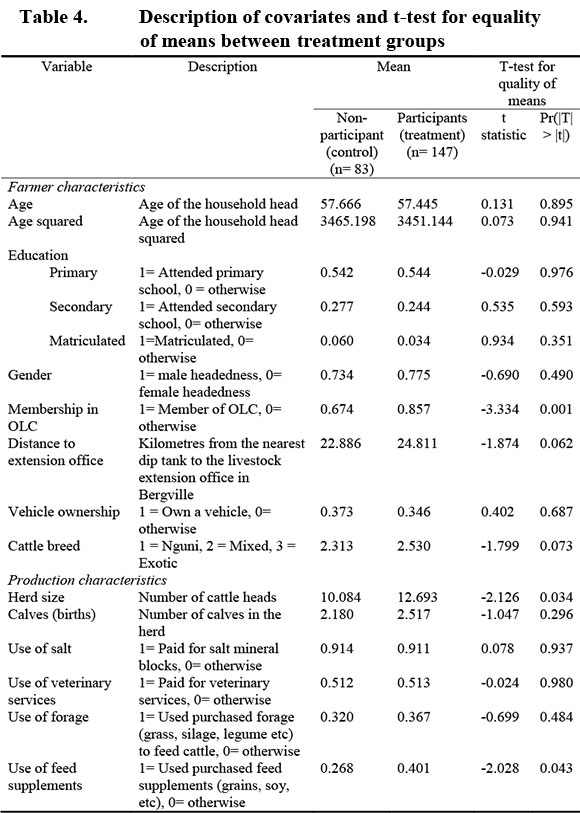
The production characteristics in Table 4 are the indicators for extension impact evaluation. They are also controlled for in the Probit model. Mixed and exotic breeds dominated in the sample, with the participating group producing significantly more mixed breed than the non-participating group. The average cattle herd sizes ranged from 10 to 12 animals in the control and treatment group, respectively, and this difference was statistically significant. Interviewed households had about two calves at the time of interview. Although 91 % of interviewed households had purchased salt mineral blocks, the average rate of usage of veterinary services and forage was only 51 % and between 32 and 36%, respectively. The average rate of feed supplement use was 26 % and 40 % among control and treatment group, respectively, and this difference was statistically significant.
To match participants and non-participants based on the propensity scores, the study used two different algorithms and compares their results. For a participating farmer i and non-participating farmer j, the nearest neighbour matching algorithm calculates the absolute difference between propensity scores as follows.

This study also uses a kernel matching, a non-parametric method that compares each participating farmer to a weighted average of the outcomes of all non-participants, placing higher weights to non-participants with propensity scores closer to that of the participant. Under this technique, for a participating farmer i, the associated matching outcome is given by (Deschamps-Laporte, 2013):

where K(.) is a kernel function, and h is a bandwidth parameter.
4. RESULTS AND DISCUSSION
4.1 Effect of producers' characteristics on participation in livestock extension programmes
The results of the participation model are shown in Table 5. Contrary to apriori expectation, the results show that, compared to illiterate farmers, cattle farmers that have attended or graduated from high school are not likely to participate in extension programmes as contact farmers. All other factors remaining constant, the propensity of becoming a contact farmer is 19 and 38 % lower for farmers that have attended or graduated from high school, respectively. A plausible explanation is that, to the extent that educated farmers have more ability to assess the costs and benefits of participating in programmes, the results would suggest that either the benefits of livestock extension information are lower, or the opportunity costs of accessing that information are too high. Even though the results are consistent with the finding of a similar study by Erbaugh, Donnermeyer, Amujal, & Kidoido (2010) in Uganda, this explanation can only be validated by the results of the impact evaluation in the subsequent subsection.
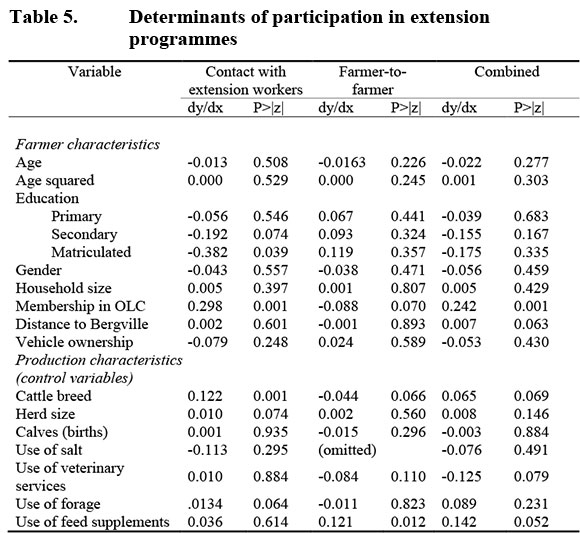
The results further show that membership in OLC increases the farmer's likelihood of participating in extension contact sessions by 30 %, while decreasing the likelihood of engaging in farmer-to-farmers sessions by 9 %. Overall, group membership increases the propensity to participle in livestock extension programmes by 24 %. These findings suggest that farmers with membership in commodity groups are more likely to capitalize on scale economies to seek direct contacts with extension personnel at much lower cost. Given the technology-centred nature of agricultural services deliveries in South Africa, the results would also suggest that commodity association increase the ease with which extension workers reach out to a large cross section of their target beneficiaries and reduce the cost of extension service delivery. To a certain extent, these empirical findings suggest that livestock extension model in the KZN province could be largely commodity-focused and supply-driven.
Unexpectedly, the distance to the extension office (Bergville), an indicator of cost of access to extension information in the model, is positive and significant. Cattle farmers living farther from the extension office are more likely to participate in extension programmes. Two plausible explanations apply. This could be a consequence of lack of access to alternative (and better) sources of information in remote areas, or a result of rural development policy prioritizing and targeting farmers living in remote communities in their intervention strategies.
Some production variables also turn out to be significant in the model. The positive marginal effect of cattle breed suggests that shift to mixed and pure exotic breeds influence positively participation in all extension models. A plausible explanation is that the indigenous Nguni breed requires lesser managerial capital as it is more fertile, matures earlier, and is well adapted to harsh bio-physical environment and low quality feed compared to other breeds (Bayer, Alcock, & Gilles, 2004). From a demand viewpoint, the positive effect of herd size in the contact session model suggests that, by capitalizing on economies of size, cattle farmers are able to spread the cost of accessing extension information over the number of units produced. Contrary to a priori expectations, the results show a negative effect of veterinary services usage in the combined participation model. The results also show that the use of forage (e.g. grasses, silages and legumes) in animal feeding is significantly associated with participation in contact sessions participation. Lastly, the results reveal that the usage of feeding supplements in cattle production is significantly positive in the farmer-to-farmer and combined participation models.
4.2 Effect of participation in livestock extension programmes on cattle production
The Probit models are used to generate the propensity scores for the adopted matching algorithms. To test the common support assumption, the propensity scores summarized in Table 6 show that, for all farmers, the average probability of participating in contact session, farmer-to-farmer session, or both is 56, 11 and 63 %, respectively. Figure 2 shows the overlaps of the propensity scores of the participating and non-participating farmers. In the majority of the propensity score classes, there is a certain number of participating (i.e. treated) and non-participating (i.e. untreated) farmers. However, it can be observed that the contact session and combined participation models shows better distribution.


Tables 7 and 8 report the ATT estimates for the set of outcome variables using the three scores specified above. The results presented in these tables are based on the nearest neighbour and kernel matching methods, respectively. Given that the survey design oversampled participating farmers, and that the distribution of propensity scores differs considerably between participant and non-participant farmers, the nearest-neighbour matching is done with replacement.
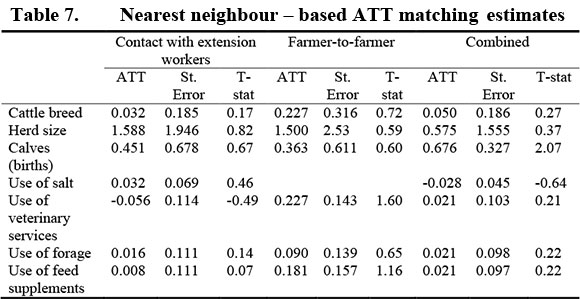
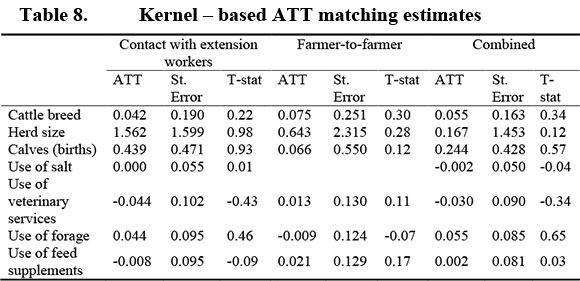
In the combined model, farmers participating in livestock extension programmes produce more calves than their control counterparts. In terms of input use, the results of the nearest-neighbour matching method further show that rate of use of veterinary services is higher among farmers participating in farmer-to-farmer sessions than among their control counterparts. However, these results are not verified across both matching methods, as similar estimates and stand errors were not obtained using the kernel matching method. There is no evidence that treated households are likely to use salt, probably because the usage rate among control farmers is already high. However, despite the lower rate of forage and feed supplement usage, the results show no significant impact of extension programmes.
These results validate the empirical findings of the participation model. Notably, the vanishing benefits of livestock extension programmes (especially the contact session with extension workers) for cattle farmers explains the finding that more educated farmers are less likely to participate in the livestock extension programmes.
There are two major information problems that can help explaining such failure of government-run extension services. As the new institutional economics explain, extension service delivery is transaction cost-intensive, and the demand-driven extension information is often more discretionary and specific (Birner & Anderson, 2007). Information asymmetry makes extension workers unable to determine what individual farmers actually need, and to delivering "standardized", rather than specific information. Moreover, information asymmetry between field extension workers and their managers creates a principal-agent problem, given that these field workers often cover vast rural areas and agricultural, their performance indicator, often depend on numerous exogenous factors such climate.
4. CONCLUSION
The central and provincial governments continue to invest funds in agricultural extension in order to uplift the productivity and safeguard the multifunctionality of cattle farming. However, the design of appropriate extension service delivery models remains a major challenge. Despite this challenge, little research efforts have been made in order to evaluate the effectiveness of existing extension models. Against this limited background, the purpose of this study was to investigate the drivers and first-order impacts of participation in government-run livestock extension programmes in north-western KZN. Based on the PSM approach, data from a survey of 230 farmers in 13 communities of the Okhahlamba Local Municipality were used in the Probit regression to estimate the effect of farmer characteristics on the decision to participate in livestock extension programmes. The results of the Probit model were used to generate case-specific propensity scores that were matched during the evaluation of the impacts of extension information on cattle production and input use.
The results of the participation model showed that more educated farmers have lower propensity to participate in government-run extension programmes. The propensity increased with group membership and distance from the extension office. Nguni cattle farmers and farmers with relatively fewer cattle were less likely to participate in the extension programmes. Farmers using forage and feed supplements scored higher propensities. The propensities from the participation model were matched using the nearest neighbour and kernel algorithms in order to estimate the ATTs. Signs of benefits from participating in livestock extension programmes in terms of cattle production and input use were scant. Generally, farmers participating in livestock extension programmes produced more calves than their control counterparts, whereas those participating in farmer-to-farmer extension sessions had higher rates of use of veterinary services than their control counterparts. These findings, however, were not robust, i.e unequivocally observed across different PSM algorithms, showing the limited success of the current extension model.
The limited success of extension programmes signifies the need for making the extension service delivery more demand-driven or exploring alternative agricultural extension approaches that focus more on the specific needs of farmers. In this endeavour, the policy should provide for strategies to ensure the accountability of extension workers at local level. Decentralization of extension services offers an appropriate turnaround strategy through devolution and deconcentration. This includes the transfer of agricultural extension budget authority to smaller local government units such as the ward. The limited success of the state-led livestock extension service delivery can also be addressed by tapping into market-based extension models. To overcome the market-failure inherent to their public good nature, extension services delivery could be integrated into institutional arrangements such as contract farming.
The policy should also explore alternatives extension models such as the advisory and facilitation models. Under these models, farmers and researchers are actively engaged in a learning process to which extension workers are simply facilitators. Leveraging on farmers' strengths (i.e. their experiences and assets), these approaches can ensure the optimal realization of their livelihoods' potentials.
REFERENCES
ANANDAJAYASEKERAM, P., RANJITHA, P., SINDU, W., & DIRK, H. (2008). Concepts andpractices in agricultural extension in developing countries: A source book. Nairobi, Kenya: International Livestock Research Institute. [ Links ]
BAGI, F. S., & BAGI, S. K. (1989). A model of farm-level demand for extension information. North Central Journal ofAgricultural Economics, 11(2), 297-307. [ Links ]
BARRETT, C. B. (2008). Smallholder market participation: Concepts and evidence from eastern and southern Africa. Food Policy, 33(4), 299-317. [ Links ]
BAYER, W., ALCOCK, R., & GILLES, P. (2004). Going backwards?-moving forward?-Nguni cattle in communal Kwazulu-Natal. Presented at the Deutscher Tropentag, Berlin, Germany: Humboldt University of Berlin. [ Links ]
BIRKHAEUSER, D., EVENSON, R. E., & FEDER, G. (1991). The economic impact of agricultural extension: A review. Economic Development and Cultural Change, 39(3), 607-650. [ Links ]
BIRNER, R., & ANDERSON, J. R. (2007). How to make agricultural extension demand-driven: The case ofIndia's agricultural extension policy (Discussion Paper No. 00729) (p. 139). Washington, D.C.: International Food Policy Research Institute. [ Links ]
COETZEE, L., MONTSHWE, B. D., & JOOSTE, A. (2006). The marketing of livestock on communal lands in the Eastern Cape Province: constraints, challenges and implications for the extension services. South African Journal ofAgricultural Extension, 34(1), 81103. [ Links ]
DAVIS, K. (2008). Extension in sub-Saharan Africa: Overview and assessment of past and current models and future prospects. Journal ofInternational Agricultural and Extension Education, 15(3), 15-28. [ Links ]
DAVIS, K., NKONYA, E., KATO, E., MEKONNEN, D. A., ODENDO, M., MIIRO, R., & NKUBA, J. (2012). Impact of farmer field schools on agricultural productivity and poverty in East Africa. World Development, 40(2), 402-413. [ Links ]
DEHEJIA, R. H., & WAHBA, S. (2002). Propensity score-matching methods for nonexperimental causal studies. Review of Economics and Statistics, 84(1), 151-161. [ Links ]
DERCON, S., GILLIGAN, D. O., HODDINOTT, J., & WOLDEHANNA, T. (2009). The Impact of Agricultural Extension and Roads on Poverty and Consumption Growth in Fifteen Ethiopian Villages. American Journal of Agricultural Economics, 91(4), 10071021. [ Links ]
DESCHAMPS-LAPORTE, J.-P. (2013). The impact of extension services on farming households in Western Kenya (Working Papers No. 2013:5). Örebro, Sweden: Örebro Business School. [ Links ]
DOSS, C. R., & MORRIS, M. L. (2000). How does gender affect the adoption of agricultural innovations? Agricultural Economics, 25(1), 27-39. [ Links ]
DÜVEL, G. H. (2004). Developing an appropriate extension approach for South Africa: process and outcome. South African Journal ofAgricultural Extension, 33, 1-10. [ Links ]
ELIAS, A., NOHMI, M., YASUNOBU, K., & ISHIDA, A. (2013). Effect of agricultural extension programme on smallholders' farm productivity: Evidence from three peasant associations in the highlands of Ethiopia. Journal ofAgricultural Science, 5(8), 1916- 9752. [ Links ]
ELLEBOUDT, R. (2012). Are conservation agriculture practices an interesting option for the smallholder farmer communities of the Okhahlamba Local Municipality, KwaZulu-Natal, South Africa?. Universiteit Gent, Gent, Belgium. [ Links ]
ERBAUGH, J. M., DONNERMEYER, J., AMUJAL, M., & KIDOIDO, M. (2010). Assessing the impact of farmer field school participation on IPM adoption in Uganda. Journal ofInternational Agricultural and Extension Education, 17(3), 5-17. [ Links ]
EVENSON, R. E. (2001). Economic impacts of agricultural research and extension. In B. L. Gardner & G. C. Rausser (Eds.), Handbook of agricultural economics (Vol. 1, pp. 573628). Amsterdam, the Netherlands: Elsevier Science. [ Links ]
GROENEWALD, J. A., & JOOSTE, A. (2012). Smallholders and livestock markets. In H. D. van Schalkwyk, J. A. Groenewald, G. C. G. Fraser, A. Obi, & A. van Tilburg (Eds.), Unlocking Markets to Smallholders: Lessons from South Africa (Vol. 10, pp. 13 - 29). Wageningen, the Netherlands: Wageningen Academic Publishers. [ Links ]
JAMISON, D. T., & MOOCK, P. R. (1984). Farmer education and farm efficiency in Nepal: The role of schooling, extension services, and cognitive skills. World Development, 12(1), 67-86. [ Links ]
KWAZULU-NATAL PROVINCIAL TREASURY. (2011). Vote 3: Agriculture, Environmental Affairs and Rural Development. Pietermaritzburg, South Africa: KwaZulu-Natal Provincial Treasury. [ Links ]
LANGYINTUO, A. S., & MUNGOMA, C. (2008). The effect of household wealth on the adoption of improved maize varieties in Zambia. Food Policy, 33(6), 550-559. [ Links ]
LOCKHEED, M. E., JAMISON, D. T., & LAU, L. J. (1980). Farmer education and farm efficiency: a survey. Economic Development and Cultural Change, 29(1), 37-76. [ Links ]
MUSEMWA, L., MUSHUNJE, A., CHIMONYO, M., & MAPIYE, C. (2010). Low cattle market off-take rates in communal production systems of South Africa: Causes and mitigation strategies. Journal of Sustainable Development in Africa, 12(5), 209-226. [ Links ]
NDORO, J. T., & HITAYEZU, P. (2014). Drivers of cattle commercialization in rural South Africa: A combined test of transaction cost and store-of-wealth hypotheses. Agrekon, 53(3), 57-78. [ Links ]
OKHAHLAMBA LOCAL MUNICIPALITY. (2012). Final Integrated Development Plan: 2012-2017. Bergville, South Africa: Okhahlamba Local Municipality. [ Links ]
PÅLSSON, A.-M. (1996). Does the degree of relative risk aversion vary with household characteristics? Journal ofEconomic Psychology, 17(6), 771-787. [ Links ]
REPUBLIC OF SOUTH AFRICA. (2005). Norms and standards for extension and advisory services in agriculture (p. 18). Pretoria, South Africa: Department of Agriculture, Forestry and Fisheries. [ Links ]
REPUBLIC OF SOUTH AFRICA. (2011). A profile of the South African beef market value chain (p. 58). Pretoria, South Africa: Department of Agriculture, Forestry and Fisheries. [ Links ]
ROSENBAUM, P. R., & RUBIN, D. B. (1983). The central role of the propensity score in observational studies for causal effects. Biometrika, 70(1), 41 -55. [ Links ]
ROSENZWEIG, M. R., & WOLPIN, K. I. (1985). Specific experience, household structure, and intergenerational transfers: Farm family land and labor arrangements in developing COUNTRIES. THE QUARTERLY JOURNAL OF ECONOMICS, 100, 961-987. [ Links ]
STROEBEL, A., SWANEPOEL, F. J. C., & PELL, A. N. (2011). Sustainable smallholder livestock systems: A case study of Limpopo Province, South Africa. Livestock Science, 139(1-2), 186-190. [ Links ]
SWANEPOEL, F., STROEBEL, A., & MOYO, S. (EDS.). (2010). The Role of Livestock in Developing Communities: Enhancing Multifunctionality. Bloemfontein, South Africa: University of Free State (UFS) and Technical Centre for Agricultural and Rural Cooperation (CTA). [ Links ]
TAYE, H. (2013). Evaluating the impact of agricultural extension programmemes in sub-Saharan Africa: Challenges and prospects. African Evaluation Journal, 1(1), 1 -9. [ Links ]
THORNTON, P. K. (2010). Livestock production: recent trends, future prospects. Philosophical Transactions of the Royal Society B: Biological Sciences, 365(1554), 2853-2867. [ Links ]
UCHEZUBA, I. D., MOSHABELE, E., & DIGOPO, D. (2009). Logistical estimation of the probability of mainstream market participation among small-scale livestock farmers: a case study of the Northern Cape province. Agrekon, 48(2), 171-183. [ Links ]
VENKATESH, V., MORRIS, M. G., & ACKERMAN, P. L. (2000). A longitudinal field investigation of gender differences in individual technology adoption decision-making processes. Organizational Behavior and Human Decision Processes, 83(1), 33-60. [ Links ]
WILLIAMS, B., MAYSON, D., DE SATGÉ, R., EPSTEIN, S., & SEMWAYO, T. (2008). Extension and smallholder agriculture: Key issues from a review of the literature. Cape Town, South Africa: Phuhlisani. [ Links ]
WOOLDRIDGE, J. M. (2002). Econometric analysis of cross section and panel data. Cambridge, MA: The MIT press. [ Links ]
WORDOFA, M. G., & SASSI, M. (2014). Improving Smallholder Farmers' Income through Farmer Training Centers: an Impact Evaluation in Haramaya District, Ethiopia (No. 14/7) (p. 48). Pavia, Italy: Natural Resources, Agricultural Development and Food Security. [ Links ]
WORTH, S. (2006). Agriflection: A learning model for agricultural extension in South Africa. The Journal ofAgricultural Education and Extension, 12(3), 179-193. [ Links ]
WORTH, S. (2012). Agricultural extension in South Africa: status quo report. Pretoria, South Africa: Department of Agriculture, Forestry and Fisheries. [ Links ]














